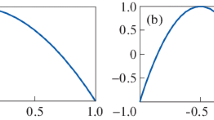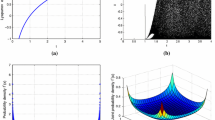Abstract
This paper presents a novel reconstruction approach of digital image in compressive sensing by the use of mean shift of different chaotic sequence to the measurement matrix. This matrix preserves better details of the structures of the recovered images, and enables a systematic construction of the measurement matrices of it. This proposed approach provides not only visible Peak Signal to Noise Ratio improvements over state-of-the-art methods (e.g. the Gaussian random matrix method) but also better preservation of the image structures during compression, which in turn enables better visual quality in image recovery, as illustrated in our experimental results.









Similar content being viewed by others
References
Cheng Y (1995) Mean shift, mode seeking, and clustering, Pattern Analysis and Machine Intelligence. IEEE Trans 17(8):790–799
Yu-Ren L, Kuo-Liang C, Chyou-Hwa C, Guei-Yin L, Wang CH (2012) Novel mean-shift based histogram equalization using textured regions. Expert Syst Appl 39(3):2750–2758
Estellers V, Thiran J-P, Bresson X (2013) Enhanced Compressed Sensing Recovery With Level Set Normals. IEEE Trans Image Process 22(7):2611–2626
Guo W, Yin W (2010) Edge CS: Edge guided compressive sensing reconstruction, Proc SPIE Visual Commun Image Process 17–23
Senoussaoui M , Kenny P, Stafylakis T, Dumouchel P (2014) A Study of the cosine distance-based mean shift for telephone speech diarization, audio, speech, and language processing. IEEE/ACM Trans 22(1):217–227
Comaniciu D, Meer P (2002) Mean shift: a robust approach toward feature space analysis, Pattern Analysis and Machine Intelligence. IEEE Trans 24(5):603–619
Mayer A, Greenspan H (2009) An adaptive mean-shift framework for MRI brain segmentation, medical imaging. IEEE Trans 28(8):1238–1250
Candes E, Romberg J, Tao T (2006) Robust uncertainty principles: Exact signal reconstruction from highly incomplete frequency information. IEEE Trans Inform Theory 52(2):489–509
Donoho D (2006) Compressed sensing. IEEE Trans Inform Theory 52(4):1289–1306
Lei Y, Barbot JP, Gang Z, Hong S (2010) Compressive sensing with chaotic sequence. IEEE Signal Process Lett 17(8):731–734
Frunzete M, Lei Y, Barbot J, Vlad A (2011) Compressive sensing matrix designed by tent map, for secure data transmission,Signal Processing Algorithms,Architectures,Arrangements,and Applications Conference Proceedings pp 1–6
Petras I (2011) Fractional-order nonlinear systems: modeling, analysis and simulation, Nonlinear Physical Science
Yin W, Osher S, Darbon J, Goldfarb D (2008) Bregman iterative algorithms for compressed sensing and related problems. SIAM J Imaging Sci 1(1):143–168
Osher S, Mao Y, Dong B, Yin W (2010) Fast linearized bregman iteration for compressive sensing and sparse denoising. Commun Math Sci 8(1):93–111
Goldstein T, Osher S (2009) The split Bregman method for L1-regularized problems. SIAM J Imaging Sci 2(2):323–343
Cai JF, Osher S, Shen Z (2009) Linearized Bregman iterations for frame-based image deblurring. SIAM J Imaging Sci 2(1):226–252
Tropp JA, Gilbert AC (2007) Signal Recovery From Random Measurements Via Orthogonal Matching Pursuit. IEEE Trans Inform Theory 53(12):4655–4666
Li P, Wang Q, Zuo W, Zhang L (2013) Log-euclidean kernels for sparse representation and dictionary learning, In ICCV
Tian WB, Kang J, Zhang Y, Rui GS, Zhang HB (2014) Weakly matching pursuit denoising recovery for compressed sensing based on kalman filtering. ACTA Electr SINICA 42(6):1762–1767
Thrampoulidis C, Oymak S, Hassibi B (2015) Recovering structured signals in noise: least-squares meets compressed sensing, compressed sensing and its applications, Springer International Publishing, ISBN:978-3-319-16041-2
Tan J, Ma YT, Baron D (2015) Compressive imaging via approximate message passing with image denoising. IEEE Transa Signal Process 63(8):424–428
Sermwuthisarn P, Gansawat D, Patanavijit V, Auethavekiat S (2015) Impulsive noise rejection method for compressed measurement signal in compressed sensing. EURASIP J Adv Signal Process pp 1–23
Lim FL, West GA, Venkatesh S (1997) Use of log polar space for foveation and feature recognition. IEEE Proceed Vision Image Signal Process pp 323–331
Ciocoiu IB (2011) Compressed sensing meets the human visual system. Springer Berlin Heidelberg, ISBN:978-3-642-24081-2
Acknowledgments
This work is partially supported by National Natural Science Foundation of China (No. 61370186, No. 61473322), State Scholarship Fund (No. 2007104752), Researching Fund for Professors and Doctors (No. 2013ARF03) of Guangdong University of Education, Research personnel fostered by Guangdong Province in Thousand, Hundred and Ten, Science and Technology Planning Project of Guangdong Province (No. 2014A010103040, No. 2014B010116001, No. 2013A011403002), Science and Technology Planning Project of Guangzhou (No. 2014J4100032, No. 201510010203), Natural Science Foundation Project of Guangdong Province (No. 2015A030310194).
Author information
Authors and Affiliations
Corresponding author
Rights and permissions
About this article
Cite this article
Chen, G., Chen, Q., Long, S. et al. The mean shift method of chaotic sequences in the study of compressive sensing. Int. J. Mach. Learn. & Cyber. 8, 1643–1654 (2017). https://doi.org/10.1007/s13042-016-0534-y
Received:
Accepted:
Published:
Issue Date:
DOI: https://doi.org/10.1007/s13042-016-0534-y




